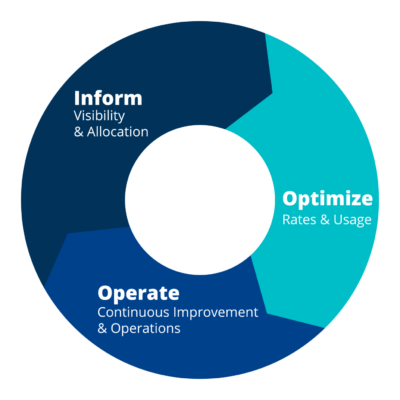When cloud computing revolutionized organizational data management and operations, significant effort was directed towards optimizing its use. Similar to DevOps, which dismantled silos and enhanced agility, FinOps has emerged as a cultural transformation uniting Finance, Engineering, and Business professionals along the three FinOps Phases: Information, Optimization, and Operation.
Through a synergistic blend of people, processes, and technology, FinOps empowers businesses to make data-driven decisions regarding their cloud expenditures. This article delves into the FinOps journey, outlining its significance and the critical phases involved.
The 3 Phases of the FinOps Journey
The FinOps journey comprises three phases that appear straightforward in theory. However, many companies face challenges during implementation. Adhering to this cycle empowers FinOps personas to act assertively, fostering the company’s maturity.
Learn about each of the phases outlined below:

Information
The journey begins with gaining insight into cloud usage to facilitate budgeting and forecasting. The cloud’s on-demand billing and easy resource scalability make immediate visibility essential, so unexpected cost increases can be immediately acted upon. This phase allows for informed decisions on resource utilization. By tagging costs, organizations can implement effective chargeback or showback models, enabling the comparison of team and product efficiencies.
Optimization
With a clear view of resource consumption, the next step is optimization. This phase involves strategic decisions on service models (e.g., on-demand, reserved instances) and resource sizing to ensure efficiency. Long-term consumption forecasts can lead to customized contracts with cloud providers, reflecting a commitment to mutual growth.
Operation
The final phase focuses on the continuous monitoring and optimization of cloud resources, aligning operational metrics with business goals. This stage facilitates the evaluation of new technology investments in terms of innovation speed, delivery quality, and financial impact.
The Information, Optimization, and Operation phases are foundational to a comprehensive cloud financial management strategy, enabling full leverage of cloud investment benefits. The FinOps journey is cyclical rather than linear, emphasizing the iterative nature of the process. Organizations may find themselves simultaneously addressing multiple phases across different departments or workloads.
While companies mature in their operations, they will naturally see a need for even more specific visibility on their consumption and will work again in the Inform phase to gain an understanding according to their FinOps Maturity level.
FinOps Journey: Where to Begin?
To embark on the FinOps journey, the best starting point is to assess your organization’s current cloud expenditure and management practices. This initial assessment will help identify areas of immediate improvement and establish a baseline for measuring future progress. Engaging FinOps personas from finance, operations, and engineering early on is crucial for fostering collaboration and ensuring that objectives align across departments.
By starting with a clear understanding of where you stand and fostering cross-departmental collaboration, your organization can smoothly navigate the FinOps journey, optimizing cloud investments for both efficiency and growth.
Interested in taking your cloud financial management to the next level? Discover how our FinOps assessment can guide your organization towards more efficient cloud cost management. Get in touch with our experts and boost your FinOps strategy.







